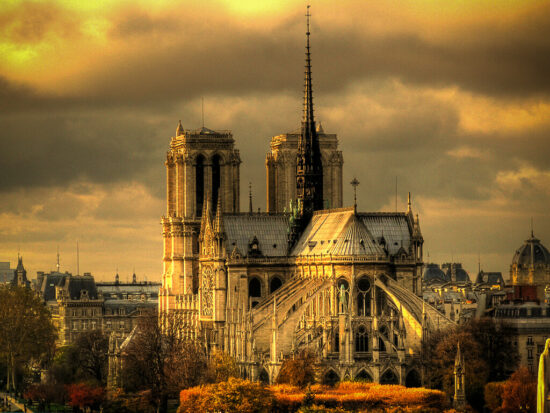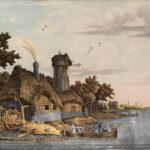Introduction
The Hunchback of Notre-Dame, written by Victor Hugo, is a timeless and captivating novel that explores themes of love, betrayal, societal prejudice, and the power of human compassion. Published in 1831, the novel takes readers on a journey through the streets of medieval Paris, providing a vivid portrayal of the city’s architecture, culture, and social dynamics. This article will delve into the plot and storyline, analyze the main characters, explore the novel’s themes and symbols, evaluate Hugo’s writing style, examine the setting and atmosphere, investigate the historical context, and discuss the impact and reception of this literary masterpiece.
Plot and Storyline
The Hunchback of Notre-Dame tells the story of Quasimodo, a deformed bell-ringer who lives in the Notre-Dame Cathedral. The novel unfolds against the backdrop of 15th-century Paris and follows the intertwined lives of Quasimodo, the beautiful gypsy dancer Esmeralda, the archdeacon Claude Frollo, and the captain of the King’s Archers, Phoebus de Châteaupers.
The main story arc revolves around the unrequited love Frollo harbors for Esmeralda and his descent into obsession and madness. Frollo’s jealousy and desire for Esmeralda lead him to commit heinous acts, setting off a chain of events that culminate in tragedy. Esmeralda, who is falsely accused of witchcraft and murder, becomes the target of public scorn and persecution, with only Quasimodo standing as her ally.
Key events include Esmeralda’s trial, where she is unjustly sentenced to death, and Quasimodo’s dramatic rescue attempt. The novel also explores the power struggles between the various factions in Paris, including the clergy, the nobility, and the common people, highlighting the political and social tensions of the time.
Characters
Victor Hugo crafts rich and complex characters that drive the narrative forward and embody the novel’s themes. Quasimodo, the hunchback, is a sympathetic and tragic figure, representing the outcasts and marginalized individuals in society. His loyalty and devotion to Esmeralda, despite her rejection, highlight the capacity for genuine love and compassion.
Esmeralda, a free-spirited and independent young woman, symbolizes beauty, purity, and the desire for freedom. Her interactions with the other characters shed light on the societal prejudices and injustices prevalent in medieval Paris.
Claude Frollo, the archdeacon, undergoes a transformation from a respected scholar to a tormented villain consumed by his forbidden desires. Frollo’s internal struggle reflects the destructive consequences of uncontrolled passions and the conflict between duty and personal gratification.
Phoebus de Châteaupers represents the shallow and self-serving nature of the nobility. His betrayal of Esmeralda exposes the hypocrisy and moral bankruptcy of the ruling class.
Themes and Symbols
The Hunchback of Notre-Dame explores several overarching themes, such as the destructive power of obsession, the consequences of societal prejudice, the search for identity and belonging, and the redemptive nature of compassion. Hugo uses vivid symbols throughout the novel to reinforce these themes and deepen the reader’s understanding.
The Notre-Dame Cathedral serves as a powerful symbol of both spiritual sanctuary and human frailty. Its Gothic architecture represents the beauty and grandeur of the human spirit, while the decaying state of the cathedral mirrors the moral decay of society.
The hunchback Quasimodo embodies the theme of inner beauty and the capacity for love and empathy beneath physical deformity. His physical appearance contrasts with his inner nobility, challenging societal norms and prejudices.
Writing Style
Victor Hugo’s writing style in The Hunchback of Notre-Dame is characterized by its richness, vivid descriptions, and attention to detail. His use of poetic language, metaphors, and intricate imagery evokes a strong emotional response from the reader, immersing them in the world of medieval Paris.
Hugo’s narrative structure oscillates between moments of intense action and introspection, creating a dynamic and engaging reading experience. His ability to seamlessly interweave historical facts, philosophical musings, and personal anecdotes enhances the depth and complexity of the story.
Setting and Atmosphere
The novel is set in 15th-century Paris, a time of political and social unrest. The city itself becomes a character, with its winding streets, bustling markets, and towering cathedral providing a vivid backdrop for the events that unfold. The Gothic atmosphere of Notre-Dame Cathedral and the claustrophobic streets of Paris contribute to the novel’s dark tone and sense of impending doom.
Historical, Social, or Political Context
The Hunchback of Notre-Dame is deeply rooted in its historical, social, and political context. Hugo uses the novel to criticize the societal injustices and inequalities of his time, shedding light on issues such as class divisions, religious hypocrisy, and the mistreatment of marginalized groups. The novel reflects the tensions between the church and the state, as well as the struggle for power between different social classes. Hugo’s critique of societal norms and the treatment of outcasts and gypsies resonates with the broader social and political movements of the 19th century.
Impact and Reception
Upon its publication, The Hunchback of Notre-Dame received both critical acclaim and popular success. It captured the imagination of readers with its compelling characters, intricate plot, and vivid descriptions of Paris. The novel’s exploration of complex themes and its social commentary left a lasting impact on literature, influencing subsequent works in the Gothic, Romantic, and Realist traditions.
The Hunchback of Notre-Dame has been adapted into numerous stage plays, films, and musicals, further cementing its cultural significance. It remains a beloved and enduring classic, continuing to resonate with readers across generations.
How does Victor Hugo use the character of Quasimodo to challenge societal norms and prejudices?
Victor Hugo uses the character of Quasimodo, the hunchback, to challenge societal norms and prejudices by highlighting the stark contrast between his physical appearance and his inner nobility. Quasimodo has a kind and compassionate heart despite the fact that society has marginalized and shunned him because of his deformity. Through Quasimodo, Hugo emphasizes the importance of looking beyond external appearances and recognizing the inherent worth and humanity in all individuals, regardless of their physical attributes. Quasimodo’s unwavering loyalty, selflessness, and capacity for love challenge the superficial judgments and biases prevalent in society.
What are the major symbols in The Hunchback of Notre-Dame and how do they contribute to the story’s meaning?
One of the major symbols in The Hunchback of Notre-Dame is the Notre-Dame Cathedral itself. The cathedral represents both a physical and metaphorical sanctuary, embodying the grandeur of human achievement as well as the fragility and decay of societal values. Its Gothic architecture reflects the beauty and spiritual aspirations of humanity, while its crumbling state mirrors the moral decline and corruption of society.
Another symbol is the hunchback Quasimodo, who represents the theme of inner beauty and the capacity for love and empathy beneath physical deformity. Quasimodo’s appearance serves as a metaphor for the societal outcasts and marginalized individuals who are often overlooked or mistreated. His character challenges the reader to question preconceived notions of beauty and to recognize the inherent worth and humanity in all individuals.
How does the historical and social context of 15th-century Paris influence the narrative and themes of The Hunchback of Notre-Dame?
The historical and social context of 15th-century Paris greatly influences the narrative and themes of The Hunchback of Notre-Dame. The novel reflects the tensions and power struggles between different social classes, such as the clergy, nobility, and common people. These divisions are depicted through the interactions between the characters and the conflicts that arise.
The novel also explores the societal prejudices and injustices prevalent at the time, particularly towards marginalized groups such as gypsies. Victor Hugo critiques the mistreatment and discrimination faced by these groups, using the character of Esmeralda, a gypsy dancer, to shed light on the social inequalities and biases of the era.
Furthermore, the novel reflects the broader historical and cultural movements of the 19th century, including the rise of Romanticism and the questioning of traditional institutions such as the Church. The social, political, and cultural context of the time adds depth and complexity to the themes explored in the novel, highlighting the author’s critique of societal norms and injustices.
Final Conclusions
The Hunchback of Notre-Dame stands as a testament to Victor Hugo’s literary genius and his ability to weave together intricate narratives, complex characters, and profound themes. Through its exploration of love, betrayal, prejudice, and compassion, the novel offers a timeless commentary on the human condition and the search for acceptance and redemption. The vivid setting, powerful symbols, and evocative writing style contribute to a deeply immersive reading experience. The novel’s impact on literature and its enduring popularity attest to its status as a masterpiece that continues to captivate and move readers to this day.
Sources
The Hunchback of Notre-Dame – Wikipedia
The Project Gutenberg eBook of Notre-Dame de Paris, by Victor Hugo






